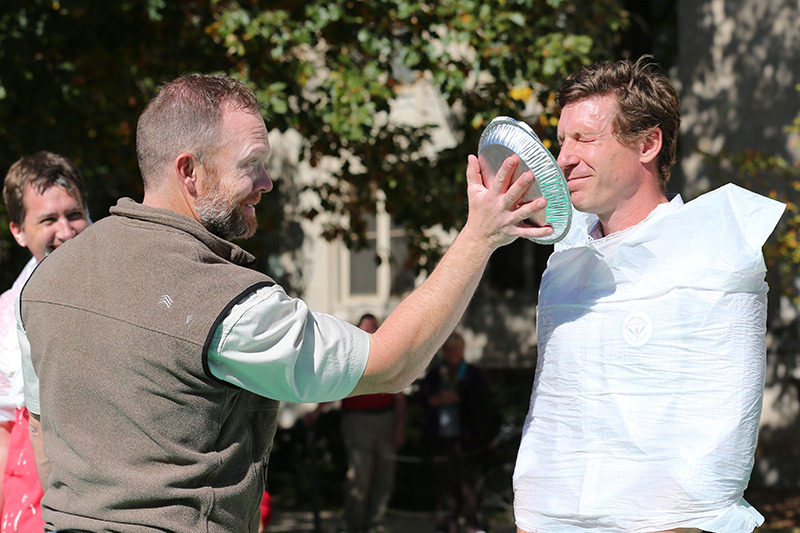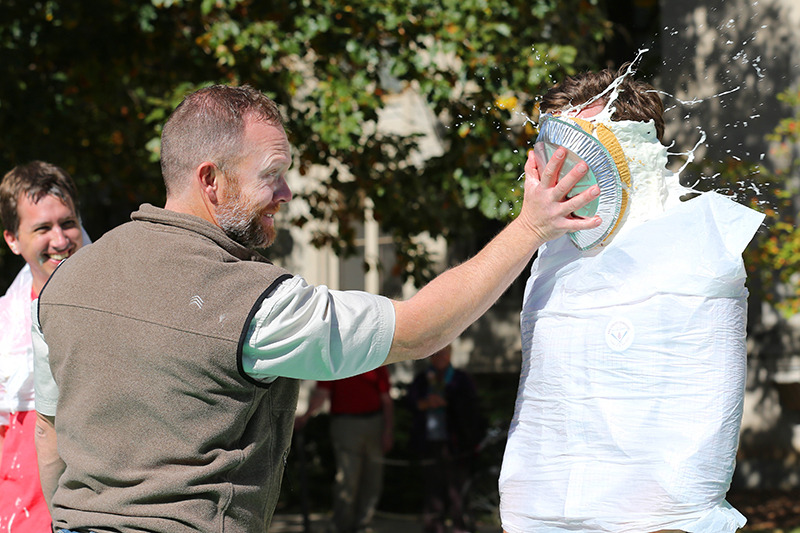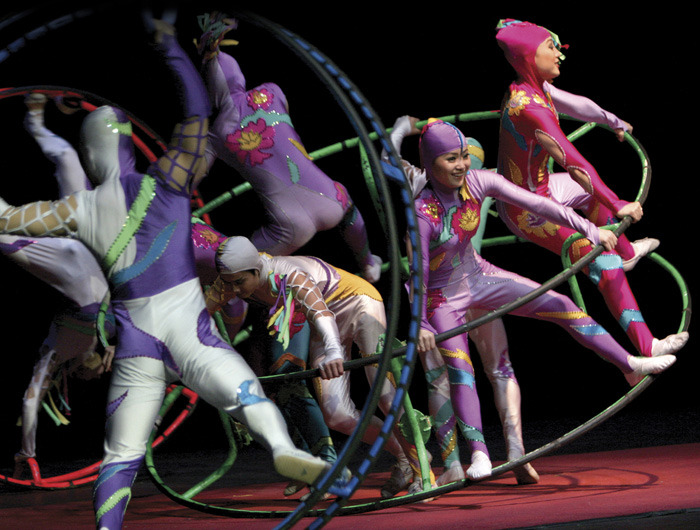Campus building addresses are set; implementation pieces will continue into the spring

Central campus buildings like Pearson Hall, whose location caters better to pedestrians than vehicles, received street addresses in the university's new building address project. Photo by Christopher Gannon.
Several years in the making, street addresses have been finalized for more than 650 campus locations. In addition to academic and residence system buildings, the effort includes parking lots, storage facilities, utility sites and outdoor recreation and athletics areas. Places such as the campanile, central campus lawn and Lake LaVerne even have their own addresses.
Learn more
A project website includes building address lists and a Q&A.
Use of building addresses will begin on Jan. 1, 2016, with implementation continuing into early March. Key implementation pieces include refacing building signs, adding street addresses to the university's online directory and revising ISU printing services templates for items such as business cards and letterhead. Additionally, the U.S. Postal Service will assign new ZIP+4 codes for campus street addresses.
In the meantime, employees are asked to learn their street address, and units should develop a plan -- once ZIP+4 codes are known -- to share their new address with vendors, clients and other constituents.
Landscape design services project manager Chris Strawhacker, who's overseeing the project for facilities planning and management (FPM), said a primary reason for street addresses is to integrate campus with the local emergency response system and shorten response times for emergency personnel. Street addresses also should help visitors with wayfinding and simplify the task for package delivery and taxi-type services.
Where can I find my address?
A project website features an alphabetical list of building addresses and a Q&A document, among other resources. Street addresses also have been loaded into the Iowa State building information database on FPM's website.
Matching the city grid
The starting point in assigning addresses was to align campus with the city of Ames grid, for example 100-numbered buildings in the first block north of Lincoln Way or 2500-sequenced buildings west of Welch Avenue.
Strawhacker said one challenge is that some campus buildings aren't adjacent to a named street. In most of those cases, a building address takes the named street nearest its front door. For example, Marston Hall, Durham Center and Pearson Hall have Morrill Road addresses; Catt Hall has an Osborn Drive address; Black Engineering has a Union Drive address.
In two cases, a previously unnamed road received a name. They are:
- Veenker Drive, the east-west road connecting the Veenker golf course clubhouse to Stange Road
- ISU C Drive, the east-west road off University Boulevard to the Veterinary Medicine Research Institute ("ISU" to clarify it's a campus road and "C" to distinguish it from the Vet Med campus "A" and "B" entrances off South 16th Street)
"Our goal was to minimize road naming," Strawhacker said. "If there was an adjacent, named street, we tried to use it."
An advisory committee, with representatives from public safety, residence, postal and parcel, information technology and university marketing, provided guidance on concerns identified during the addressing process.
Mail addresses, stationery reprints
Street addresses will require an additional line on mail delivered to campus. Mail addresses also should contain a building's ZIP code "plus 4." The U.S. Postal Service has begun assigning ZIP+4 codes to the university's building address list. When they're set -- and that date isn't known yet -- the new codes will replace the four-digit building codes currently used by ISU postal and parcel services for campus delivery.
University marketing and ISU printing services are developing new printing templates that incorporate a building address line and new ZIP+4 code. Strawhacker said there is no deadline to replace printed items and encouraged units to use existing supplies of business cards, letterhead and other products. Printing services will not accept orders for business cards and stationery until the new ZIP+4 codes are available.
Strawhacker said mail to campus buildings, whether originating off or on campus, will continue to be routed through ISU postal and parcel services. The exceptions are the Memorial Union and Parks Library, which receive direct deliveries from the U.S. Postal Service. The residence department will continue to sort and route mail to residence halls. The U.S. Postal Service also delivers to the student apartment communities north of campus.
Building signs
Strawhacker said the brown panels on the freestanding building signs will be removed and refinished in a phased process that begins in the center of campus and proceeds outward, finishing with the Frederiksen Court student apartments. The process is expected to take about four months, beginning later this semester.
A refinished sign will include the red and white university nameplate, a building name and its street address. Due to space restrictions, unit names will be removed from building signs.
Strawhacker said the cost of switching out the signs will be covered by university funds committed to this project.
Online map sites
FPM web technologist John Hoffman, who also is a regional lead for Google Maps, will add street addresses to campus buildings on Google Maps. Iowa State has no control over how accurately other navigation websites calculate campus street addresses.
Stewart named first VP for diversity and inclusion
Reginald Stewart, chief diversity officer at the University of Nevada, Reno, has been selected vice president for diversity and inclusion at Iowa State. His appointment, subject to State Board of Regents approval at the regents' Oct. 22 meeting, begins on Dec. 1.

Stewart
Stewart, who served as the inaugural chief diversity officer at University of Nevada, also will be the first to hold Iowa State's newly created vice presidential post. President Steven Leath created the position in response to a recommendation in a comprehensive study of ISU diversity programs.
"Iowa State’s commitment to diversity isn’t simply measured by statistics; it’s a principle that guides our land-grant mission of education, research, and service," Leath said. "I am very pleased to bring Dr. Reginald Stewart on board as our new Vice President for Diversity and Inclusion to enhance our campus environment in a way that values and celebrates diversity."
As Iowa State's chief diversity officer, Stewart will advise senior leadership on diversity planning efforts. He will develop initiatives to increase institutional diversity through recruitment and retention of faculty, staff and students. He also will serve as an advocate for diversity, equity and inclusion within the university, Ames community and the state.
Getting started
Stewart says he'll start his work at Iowa State with a lot of conversations.
"The key thing about diversity and inclusion work is social capital," he said. "That is the most important thing. It's your ability to work with people and that only comes from being sincere, honest and taking the time to engage people.
"It's not immediately transactional. You don't come in here and do x, y, z. What you do is you come in and establish the framework from which you can work. That means engaging with people who are invested in long-term success."
Noting that he has spent nearly 15 years in student services and student affairs, Stewart said he remains a very strong student advocate.
"Sometimes when we talk about diversity and inclusion, there's an assumption that we're only taking about people who define themselves in specific types of categories," he said. "But the reality is diversity and inclusion are beneficial for all the students who are studying at Iowa State because they're going to graduate and move into a much more diverse workforce than most of us have ever encountered."
Prior posts
Stewart has served as chief diversity officer and adjunct professor of educational leadership at the University of Nevada since 2011. His prior positions at Nevada include director of the Center for Student Cultural Diversity and counselor for the federally funded TRiO Scholars Program.
Stewart served as diversity consultant to the city of Reno and the Reno police department. He also was a coordinator-counselor for Upward Bound, a TRiO program, at Huston-Tillotson College, Austin, Texas, and testing coordinator in the Disability Resource Center at San Francisco State University, California.
Stewart earned a bachelor's degree in sociology (1993) from San Francisco State University, and master of education in educational leadership (2003) and doctorate in higher education administration (2010) from the University of Nevada.
Flat tuition proposed next year for ISU, UNI resident undergraduates
Iowa State and University of Northern Iowa resident undergraduates would get a reprieve while their counterparts at the University of Iowa play catch-up, under a 2016-17 tuition proposal going to the state Board of Regents next week. The board will meet Oct. 21-22 in Iowa City; a meeting schedule and agenda items are online. Audio of public portions of the meeting will be streamed live on the board's website.
In September, the board approved a 3 percent tuition increase for 2016 spring semester for resident undergraduates – at UNI and Iowa State only. Their tuition would remain unchanged ($6,848 at both universities) for the 2016-17 academic year as proposed, while Iowa resident undergraduate tuition would be raised 3 percent, to $6,878.
Proposed ISU tuition increases are:
- 4 percent, for resident veterinary medicine students
- 3 percent, for nonresident undergraduates, nonresident veterinary medicine students and all graduate students
Supplemental tuition
Iowa State will request its first supplemental tuition since 2011-12, $500 per year for three years, for all nonimmigrant, non-citizen international students. The revenue would help cover costs of additional services needed for international students, currently funded by all students. These services include: additional time with academic advisers, English language training and reporting requirements for international students, as well as higher costs in admissions work and financial transactions.
Since 2006-07, the board has approved multiple-year supplemental tuition at Iowa State for upper division undergraduates in engineering, business and ag systems technology/industrial technology; resident architecture students (all levels); and fourth-year students in the doctor of veterinary medicine program.
Mandatory student fees
Iowa State also will request a $33.50 increase to the mandatory fee for all ISU students. One piece, $20, would be used to implement Keeling and Associates' recommendations to improve the student health center. The other, a $13.50 increase to the student services fee, would support additional CyRide service and projected fuel cost increases for the bus service. As proposed, mandatory student fees would range from $1,075 to $1,337 at Iowa State next year.
A vote on the tuition and mandatory fee proposal is scheduled for the board's Dec. 2 meeting.
Income tax breaks
Graduate and professional student governments at the three regent universities will present a proposal aimed at keeping their constituents in the state following graduation. They propose a 50 percent income tax break, for five years, for regent school-educated graduate and professional students who take jobs in Iowa. The income tax break would jump to 75 percent for those who live and work in rural Iowa. The group has sent its proposal to Gov. Terry Branstad.
The group believes the tax break would:
- Help young alumni pay for their graduate or professional degree
- Dissuade graduates from moving out of state for higher salaries
- Combat the state's "Brain Drain" issue
- Help maintain the state's population, particularly in the 20- to 30-year-old age group
The board is being asked only to receive the presentation; no other action is requested.
Other business
In other Iowa State-related business, the board will:
- Receive oral updates on TIER (Transparent, Inclusive Efficiency Review) business cases by the Ad Astra (space use, course scheduling) and Pappas Consulting (e-learning, enrollment management) groups
- Receive reports on student enrollment (annual) and faculty activity (biennial)
- Consider approving the Center for Statistics and Application in Forensic Evidence in the office of the vice president for research. It is proposed as a National Institute for Standards and Technology (NIST)-sponsored center for research, education and outreach in statistical and probabilistic methods for the forensic sciences. NIST funding totals $20 million over five years, with a 5-year renewal possible.
- Approve a bond issuance schedule for calendar year 2016 that includes a sale of ISU utility system revenue bonds (approximately $13 million) in October
This won't hurt a bit

Enrollment services adviser Rachel Rudeen, left, receives a flu shot from registered nurse Jackie Smith at Iowa State's flu shot clinic (205 Technical and Administrative Services Facility) on Thursday, Oct. 8. Shots are free for Iowa State employees, while supplies last. Haven't gotten your shot yet? You better hurry. The clinic's last day is Friday, Oct. 16 (9 a.m.-4 p.m.). No appointment is necessary, but remember to bring your ISU ID. Photo by Christopher Gannon.
Associate VP for research post open to tenured ISU faculty
The Office of the Vice President for Research seeks a tenured Iowa State faculty member to serve as a full-time associate vice president for research.
Part of the vice president for research leadership team, the person in the position will develop and oversee initiatives aimed at increasing the impact and stature of ISU’s research and scholarship. Duties will include:
- Creating and administering programs to develop researchers and their capacity to pursue scholarship and form interdisciplinary groups
- Connecting researchers to funding opportunities and program managers
- Building and maintaining external relations with ISU stakeholders and the public
Details about the position and how to apply are posted on the ISU Jobs website.
Did somebody say pie?


Food science and human nutrition associate professor Matthew Rowling gave kinesiology assistant professor Robin Shook a pie to the face as one of the top vote-getters -- by way of money dropped in designated jars -- in a United Way fundraiser held by the College of Human Sciences. The event was one of many planned for the first Human Sciences Week celebration. The tent outside MacKay Hall's south entrance is host to most events, including Thursday's "cake cutting" to mark the college's 10th anniversary. On Friday, CHS clubs and organizations will be under the tent for the Food and Fun Fest (11:30 a.m.-1:30 p.m.) with displays and sales, including cherry pies, popcorn, caramel corn, mini doughnuts, fudge and refreshments. Photos by Christopher Gannon.
How do they do that?

Submitted photo.
The Golden Dragon Acrobats, an American touring company of Chinese acrobats, will perform at Stephens Auditorium on Friday, Oct. 16 (7 p.m., doors open at 6 p.m.). Sponsored by the Student Union Board, the performance is free and open to the public. 

Touring for more than 35 years, the group has performed in all 50 states and more than 65 countries across five continents. The National Association for Campus Activities has named the group "Entertainer of the Year" seven times.
